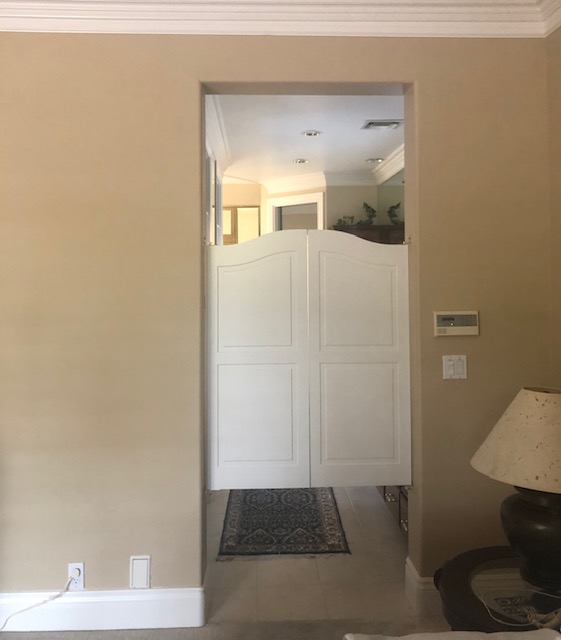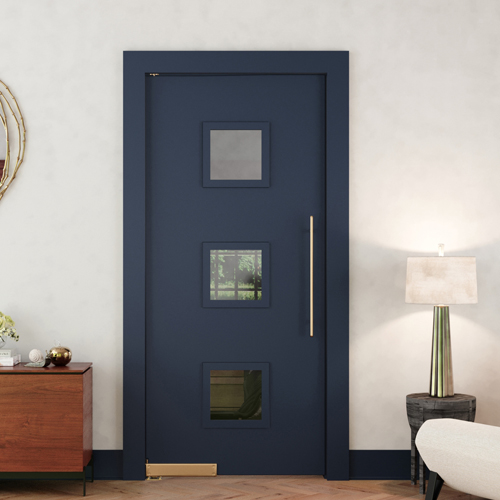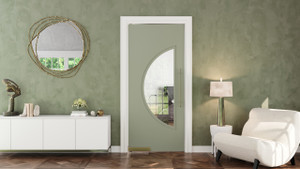
Customizable Swinging Cafe Doors for Aesthetic and Functionality
Adaptable Door Design Selections: Customizing Your Home's Aesthetic and Functionality
The doorway in a home has long been considered a metaphorical and literal threshold, marking transitions and separating spaces. However, in the fluid landscape of modern living, the mere presence of a door is no longer just about privacy and division; it's a design element that can greatly influence the ambiance and flow of space. For homeowners and architects seeking to maximize aesthetics and functionality, adaptable door designs are a burgeoning trend. In this comprehensive guide, we'll explore the realm of adaptable door designs, the various types available, and the nuanced art of selecting doors that stay in harmony with evolving lifestyles and interior trends.
Key Takeaways:
- Adaptable door styles—sliding, barn, pocket, folding—maximize space.
- Customize materials, finishes, and hardware to your design.
- Pro install + routine care ensure smooth, long-lasting performance.
Understanding Adaptable Door Designs
At their core, adaptable door designs are those that can be easily transformed to meet changing needs. These are not the traditional hinged doors that swing on a fixed path; they are flexible, space-efficient, and often serve multiple purposes. From a practical perspective, adaptable doors can be opened or closed to reconfigure living areas, offer acoustic insulation, and maximize usable areas.
What makes these doors truly exceptional, however, is their adaptability to shifting interior design aesthetics. They provide a canvas for personal expression that can be altered more easily than structural changes and are in tune with the metamorphosis of interior design styles.
Types of Adaptable Door Designs
Different types of adaptable doors offer varying functional and aesthetic benefits. Here are several popular choices:
Sliding Doors
With their sleek, unobtrusive design, sliding doors are a favorite for those looking to save space or create a minimalist look in their homes. They glide along a track and are perfect when a hinged door's swing space is not feasible. Often used for closets or room dividers, sliding doors can also be implemented in larger spaces to create a distinctive industrial look, especially when constructed of materials like glass or metal.
Barn Doors
Barn doors are renowned for their rustic charm and are mounted on tracks that allow them to slide open and close. They offer the benefits of sliding doors with the added character of their heritage-inspired design. They are particularly effective in spaces where traditional doors might be too cumbersome, and they can serve as a focal point or conversation piece, with modern iterations even suitable for urban settings.
Pocket Doors
Pocket doors are a space-saving champion, designed to slide in and out of a 'pocket' within walls when not in use. They are a master of discreet functionality, especially in rooms where every inch of square footage counts. Pocket doors are an excellent solution for small areas and are highly valued for their seamless integration with the wall, providing an unbroken and open living space when the door is open.
Folding Doors
Folding doors, or bi-folds, are known for their ability to open an entire wall to the outdoors, effectively blurring the line between inside and outside. They are versatile and can be used in both residential and commercial settings, such as in restaurants or larger living spaces. When not in use, they neatly stack to one side, allowing an unobstructed view and bringing an expansive feel to the space.
Factors to Consider When Selecting Adaptable Doors
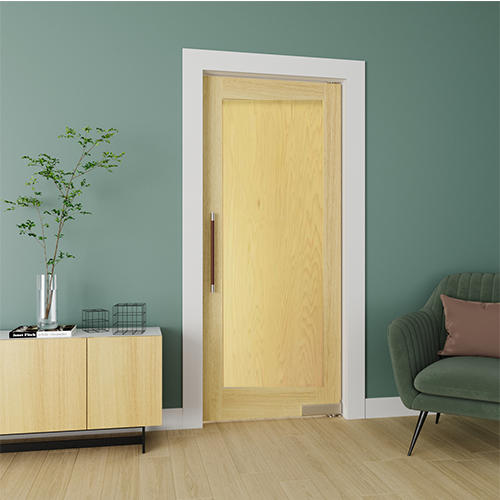
Choosing the right adaptable door for your space is a significant decision that must balance form and function. Here are key considerations:
Home Layout and Space Constraints
The layout of your home and the availability of space will dictate which adaptable door design is most suitable. For example, in a narrow hallway, a sliding or folding door may be preferred over a hinged one, as it doesn't encroach on the limited area. Understanding your space's needs and constraints will help determine the best type of adaptable door for each area.
Aesthetic Preferences and Interior Design Themes
Doors are integral components of interior design. The colors, materials, and styles you choose should complement the overall aesthetic you're looking to achieve. Whether it's a contemporary, industrial, or traditional design, each type of adaptable door can be customized to align with the chosen theme, thereby aiding the seamless integration of your design aspirations.
Functionality and Practical Use
Beyond the luxurious look, the intended use of a door is paramount. Consider factors such as noise reduction, ease of use, and maintenance. If the door is frequently operated in a high-traffic area, robust hardware systems are essential. Similarly, if privacy or noise control is a priority, you might opt for specialized acoustic pocket doors or double-glazed sliding doors.
Case Studies
To bring the concept to life, consider these case studies:
Modern Loft with Sliding Glass
In a modern loft, sliding glass doors opened to reveal a breathtaking view, effectively doubling the living space. The space was transformed into a versatile area, with a functional office space that could vanish behind a sliding glass door once work was done.
Charming Cottage with Barn Doors
A charming cottage incorporated barn doors into its design, serving as a stylish entryway to the bathroom and a space-saving solution that enhanced the coziness of the home. The barn doors' warm wood tones added character and warmth to the space.
Contemporary Urban Dwelling with Pocket Doors
A sleek, contemporary urban dwelling utilized pocket doors to create a sense of openness and flow between rooms. The concealment of the doors within the wall structure supported the home's clean lines and uncluttered look while maintaining the versatile use of the space.
Installation and Maintenance Tips
Proper installation is pivotal in ensuring your adaptable doors perform optimally.
Professional Installation
Seek professional advice and installation services, as they will ensure that the doors are fitted correctly, operate smoothly, and maintain the integrity of your space.
Maintaining Your Adaptable Doors
Regular maintenance is key to extending the lifespan of your adaptable doors. Keep the tracks clean and check for any signs of wear, such as frayed edges on the door panels or loose hardware. Address any issues promptly to prevent further damage.
Future Trends in Adaptable Door Design
 The future of adaptable door design is exciting, with advancements in materials, technology, and sustainability shaping the doors of tomorrow.
The future of adaptable door design is exciting, with advancements in materials, technology, and sustainability shaping the doors of tomorrow.
Emerging Technologies and Materials
Advances in architectural design are bringing about new materials and technologies that enhance the performance and aesthetics of doors. Smart technologies like automated opening systems, fingerprint sensors, and energy-saving materials are becoming integrated into door designs, providing heightened convenience and functionality.
Sustainable and Eco-Friendly Options
Sustainability is at the forefront of design innovation. Doors made from reclaimed wood, energy-efficient glass, and materials with low environmental impact are emerging as popular choices. These eco-friendly options offer a way to bring environmental responsibility into the design of your home without sacrificing style or function.
Conclusion
Adaptable door designs represent a convergence of functionality and fashion, embodying the adaptability and customization that modern homeowners and designers are seeking. Whether it's to save space, create a new layout, or simply add a stylish element to a room, the right adaptable door can significantly enhance your living experience.
Adopting these designs into your home not only adds a unique touch to your interiors but also highlights your commitment to a space that is truly your own, reflecting your lifestyle and identity. With a thorough understanding of the options available and the essential factors to consider, the process of selecting adaptable doors can be an enjoyable part of shaping the living spaces of tomorrow, and today.
For those ready to take the next step in personalizing their living space, the world of adaptable doors is an open — or closed—door to further creativity. It's time to open up to the possibilities.
From Function to Fashion: The Latest in Adaptable Door Design Selections
 Doors are the unsung heroes of interior design, often overshadowed by show-stopping furniture or a well-placed accent wall. Yet, they are one of the most crucial elements of any space, providing privacy, warmth, and style. The concept of adaptable door design is a game-changer, blending seamlessly into the evolving fabric of our lifestyles and architectural trends. But what distinguishes an adaptable door from its conventional counterparts, and how do you choose the best option for your home or project? This blog post dives into the nuances of adaptable door design, offering insights for creating spaces that not only look good but also serve with unparalleled versatility. Whether you're a homeowner with an eye for interior design or an architect pushing the boundaries of space utilization, the information here will guide you through making the right door choices for a more adaptive and dynamic living experience.
Doors are the unsung heroes of interior design, often overshadowed by show-stopping furniture or a well-placed accent wall. Yet, they are one of the most crucial elements of any space, providing privacy, warmth, and style. The concept of adaptable door design is a game-changer, blending seamlessly into the evolving fabric of our lifestyles and architectural trends. But what distinguishes an adaptable door from its conventional counterparts, and how do you choose the best option for your home or project? This blog post dives into the nuances of adaptable door design, offering insights for creating spaces that not only look good but also serve with unparalleled versatility. Whether you're a homeowner with an eye for interior design or an architect pushing the boundaries of space utilization, the information here will guide you through making the right door choices for a more adaptive and dynamic living experience.
Understanding Adaptable Door Designs
The beauty of adaptable door designs lies in their capability to transform a space without the need for a complete overhaul. By definition, these doors are flexible and versatile, often enabling a dual function or multiple layout configurations within a single dwelling. They cater to changes in lifestyle, family dynamics, and even seasonal shifts in space usage. Think of them as the chameleons of your interior, ready to adapt at a moment's notice.
With an increasing focus on open floor plans and multi-functional living spaces, interior doors have to do more than just separate areas. They're now visual cues that demarcate space while adding or maintaining aesthetic appeal. Their adaptability ensures they suit modern living, where rooms may transform from offices to playrooms or living rooms to dining areas, as effortlessly as flipping a switch.
Types of Adaptable Door Designs
To truly grasp the practical implications of adaptable door designs, it's critical to understand the various types available and how each serves a unique purpose. Here are a few notable examples:
Sliding Doors
Sliding doors are the quintessential space-saving door option. They hang from a track on the wall, which can be hidden or showcased as a design feature. Ideal for small homes or areas where traditional swing doors may be a hindrance, sliding doors offer a sleek, modern look while being highly functional. They come in a range of materials, from transparent glass panels that maintain a visual connection between rooms to solid wood for added privacy and soundproofing.
Barn Doors
Barn doors bring a rustic, industrial charm to any space while acting as a significant space-saver. Traditionally used in rural barns, these doors now find themselves at home in urban lofts and contemporary residences. Their unique sliding mechanism – typically attached to the top of the door – adds a focal point to the room while their ability to slide to and from conceals or reveals the space beyond.
Pocket Doors
When space efficiency is at a premium, pocket doors emerge as the silent partners of home design. These doors slide neatly into a hidden wall cavity, offering a clean, unobstructed view when open. They are a perfect choice for rooms with narrow corridors or where maintaining the entire door leaf in view isn't feasible or desirable.
Folding Doors
Folding doors, also known as bi-fold doors, offer a panoramic view of the outside world when fully opened and can cover a large expanse when closed. They are particularly popular for connecting indoor living spaces to the outdoors, seamlessly bringing the freshness of the garden into your home. Multiple configurations are possible, depending on the number of door panels, which makes them an excellent choice for those who love to entertain or wish to add a touch of luxury and space to their interiors.
Factors to Consider When Selecting Adaptable Doors
It's not enough to know the types of doors available; selecting the right one for your space involves careful consideration of your specific needs and the characteristics of your home. Here are a few vital factors to keep in mind:
Home Layout and Space Constraints
Understand your home's layout and the space you're working with. Will the door be placed in a high-traffic area? Do you need to consider clearances for furniture or foot traffic when the door is open? Is there an architectural feature you want to highlight or keep hidden? Every home is unique, and the door design must complement these individual elements.
Aesthetic Preferences and Interior Design Themes
Adaptable doors now come in a variety of finishes and materials, making it easier to find one that aligns with your interior design vision. Whether it's a sleek, modern look in a glass sliding door or the earthy, natural feel of a barn door with a reclaimed wood finish, the door design should enhance the overall design scheme of the space.
Functionality and Practical Use
Consider how the door will be used day-to-day. Will it be constantly opened and closed, or will it serve as a transition door between less-used spaces? The hardware used – from the sliding tracks to the handles – should be durable and ergonomic, ensuring a smooth operation over time.
Case Studies
Real-life examples serve as some of the best inspirations when exploring adaptable door designs. Case studies present stories of homeowners and designers who've successfully integrated these doors into their homes, sometimes solving unique spatial challenges or achieving particular design objectives.
For instance, a New York City loft might feature a set of folding doors that convert a bedroom into a living space, expanding the entertainment area when needed. On the other hand, a compact studio apartment in Tokyo could demonstrate the use of sliding barn doors, providing flexible privacy and a touch of country living in the heart of the bustling city.
Installation and Maintenance Tips
Installing doors, especially those that deviate from the standard hinged type, can be a complex task. Engaging a professional ensures that the door operates as intended and maintains structural integrity. Furthermore, regular maintenance, such as cleaning tracks or lubricating the hardware, can prolong the life of your doors and keep them looking and performing at their best.
Future Trends in Adaptable Door Design
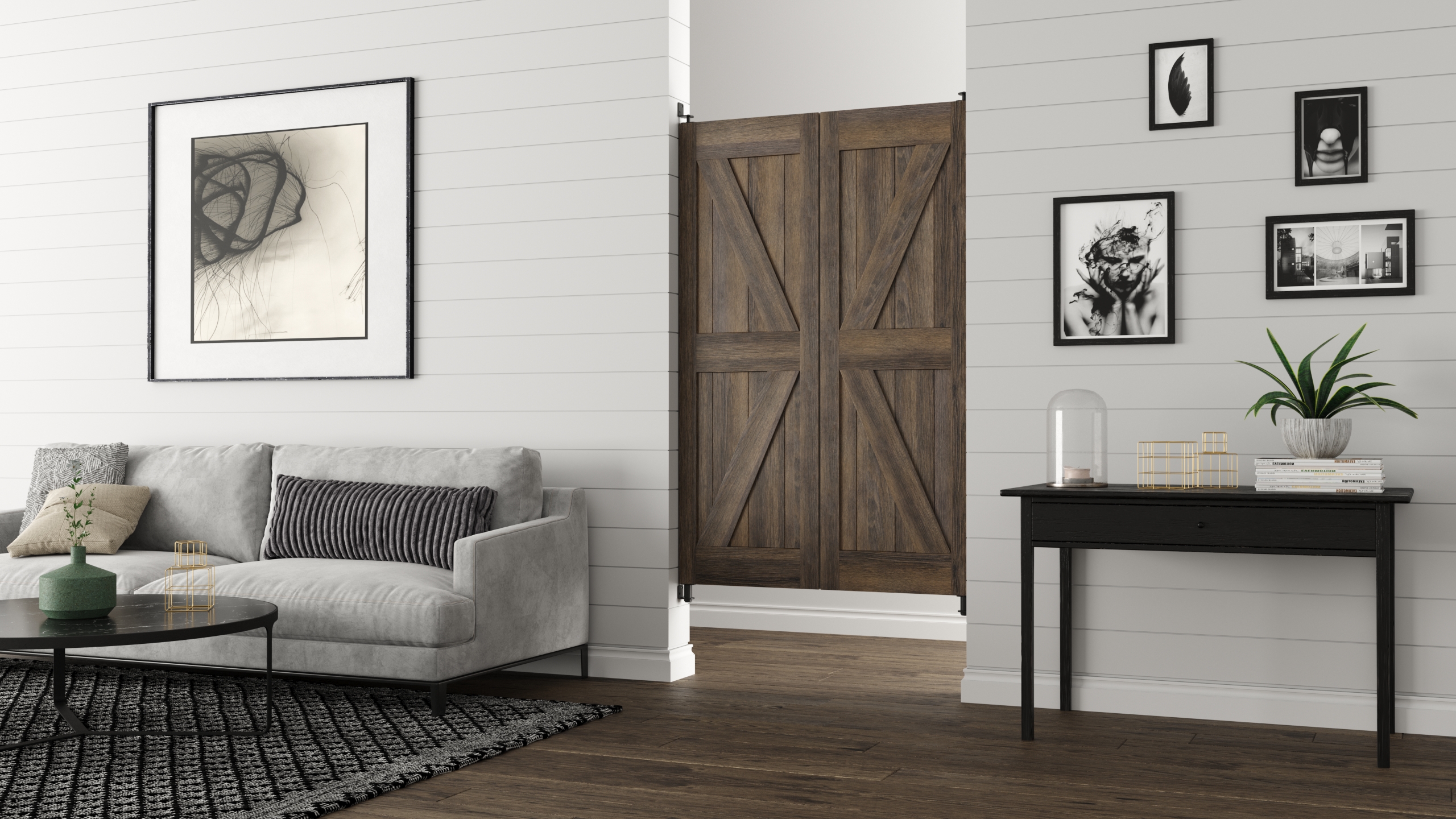 The design and functionality of interior doors continue to evolve with advancements in materials and technology. With an increased focus on sustainability and smart home integration, we're likely to see doors that not only save space but also energy, and that seamlessly blend into the home's function with the tap of a smartphone.
The design and functionality of interior doors continue to evolve with advancements in materials and technology. With an increased focus on sustainability and smart home integration, we're likely to see doors that not only save space but also energy, and that seamlessly blend into the home's function with the tap of a smartphone.
Conclusion
Adaptable door designs are not just a fad; they are here to stay, continually redefining how we interact with our living spaces. By learning how to incorporate these doors into your home and staying abreast of the trends, you can ensure that your design choices are not only stylish but also a sound investment in functionality. It's time to open the door to a world where your living space can adapt to you, not the other way around.
Now that you have a deeper understanding of adaptable door designs, take the next step. Explore different types, speak with designers, and start envisioning how these doors could transform your space. Whether you're designing your dream home or renovating an existing house, the right door can be the touchstone for a comfortable, adaptable, and stylish living environment. Choose wisely, and your door won't just open and close; it will welcome you to a new era of living.

